Side with Augustus
original south side
Far right with Children
16th and 17th C. Drawings of Slabs
from the Processional Frieze
The identity, and thus interpretation, of the 4 children toward the right of the processional frieze with Augustus has engaged scholars in perhaps the most challenging, and revealing, debate regarding any of the figures in the 2 processional friezes. Persuasive arguments have been advanced for why the children must be members of the imperial family, others for why one or more of them must be not even Romans but barbarian hostages or eastern princes.
Beginning in the late 16th century, drawings were made recording figural reliefs on blocks of marble that had recently been discovered.
We now recognize that these drawings represent sections of the processional reliefs originally on the north and south sides of the Ara Pacis Augustae. However, during the Middle Ages and Renaissance, the original location of the Ara Pacis has been totally forgotten. Thus, even though these blocks were discovered near the original location of the monument, no one associated these reliefs with the Ara Pacis.
Nevertheless, the quality and importance of the reliefs was recognized and these drawings were done partly to document these impressive new discoveries. The drawings made in the 16th and 17th centuries usually agree closely in their imagery. Although they do not have the usual characteristics of documentary drawings, the Codex Vaticanus drawings have the fewest changes and most accurately record the reliefs as rediscovered. As such, they are invaluable in helping us distinguish original carving from later additions and other changes. The drawings of slabs from the original south side processional frieze, reproduced below, support our impression that these slabs are the best preserved of all figural reliefs on the Ara Pacis.
Drawings of reliefs from the original south side are illustrated on this page. Drawings of reliefs from the original north side are illustrated in that section of this website.
TO ZOOM IN ON THE LARGE IMAGES, USE THE BUTTONS AT TOP-LEFT.
Tips for using this website
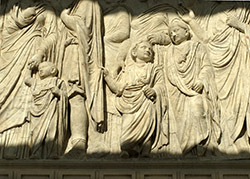
These 3 individualized children are most often identified as Germanicus, possibly Gneus Domitius Ahenobarbus, and possibly Domitia.
photo Oct. 2008
|
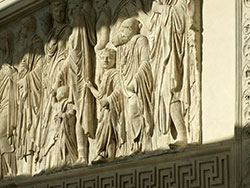
The incomplete figures at the right end of this marble slab indicates that there would have been an additional slab at the far right, almost certainly wider than the narrow space seen here.
photo Oct. 2008
|
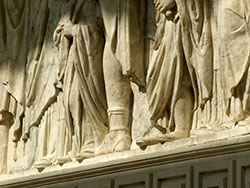
At the center is a profile view of Drusus' leg in military straps. To left and right are the lower portions of figures on his either side.
photo May 2010
|
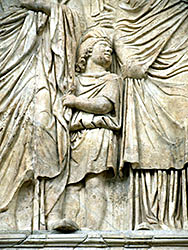
Eastern Barbarian Prince, previously thought to be Gaius Caesar, seen from below.
photo May 2010
|
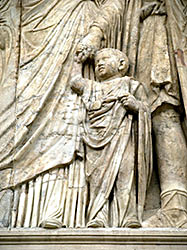
Child wearing a toga, probably Germanicus, wearing a toga and a bulla, seen from below.
photo May 2010
|
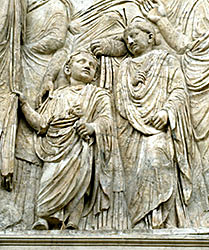
Possibly Gneus Domitius Ahenobarbus? and possibly Domitia?; each wearing a toga and a bulla, the taller girl also wearing a stola.
photo May 2010
|
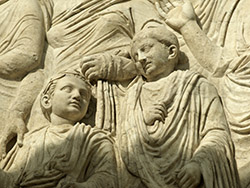
Upper bodies of possibly Gneus Domitius Ahenobarbus? and possibly Domitia?, the bust of Antonia maior behind.
photo Oct. 2008
|
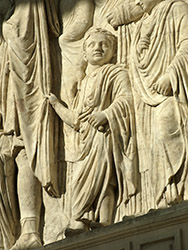
Possibly Gneus Domitius Ahennobarbus? holding the
military cloak of Drusus.
photo Oct. 2008
|
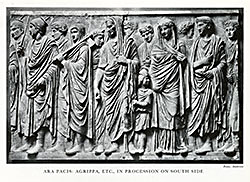
Two entire, well-preserved slabs. The join of the 2 slabs runs through the body of Agrippa, immediately behind his head. These are 2 of the prime surviving original slabs of the Ara Pacis. Compare drawings below.
"Plate XVII Ara Pacis: Agrippa, etc., in Procession on South Side".
"Rome, Anderson"
Scanned from Toynbee, The Ara Pacis Reconsidered and Historical Art in Italy, London: British Academy, 1953, pl.17. © The British Academy 1953. Reproduced by permission from Proceedings of the British Academy, vol. 39; with appreciation.
|
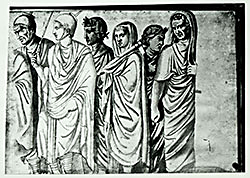
Late 16th century drawing (ca.1568-1580 CE) by an anonymous artist of the slab with Agrippa at the right. Compare image at far-right and image at far-right in row above.
Codex Ursinianus by Ligorio and Panvinius, 3439. Vatican Library, Rome.
Photo: German Archaeological Institute, Rome. Reproduced with appreciation.
|
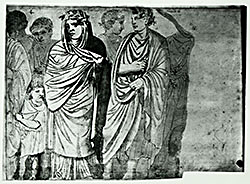
Late 16th century drawing (ca. 1568-1580 CE) by an anonymous artist of the slab with a portion of Agrippa at the left. The distinguished woman toward the center of this slab is said by some to be Livia, by others Julia. Compare image at right and image at right in row above.
Codex Ursinianus by Ligorio and Panvinius, 3439. Vatican Library, Rome.
Photo: German Archaeological Institute, Rome. Reproduced with appreciation.
|
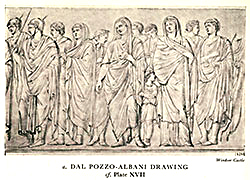
17th Century drawing (ca.1620-1657 CE) of the entire 2 original slabs joined through the body of Agripp, at center in the drawing. Compare drawings at left.
Dal Pozzo-Albani Album II, f.25, n.8280. Royal Library, Windsor Castle.
Scanned from Toynbee, The Ara Pacis Reconsidered and Historical Art in Italy, London: British Academy, 1953, pl. 29b. © The British Academy 1953. Reproduced by permission from Proceedings of the British Academy, vol. 39; with appreciation. |
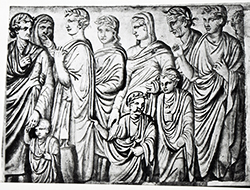
Late 16th century drawing (ca.1568-1580 CE) by an anonymous artist of portion of original slab at far right of frieze, with children. Compare images at right.
Codex Ursinianus by Ligorio and Panvinius, 3439. Vatican Library, Rome.
Photo: German Archaeological Institute, Rome. Reproduced with appreciation.
|
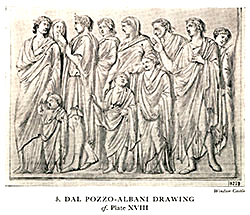
Unusually accurate and detailed 17th Century drawing (ca.1620-1657 CE) of entire original slab at far right of frieze, with children. Compare images at left and right.
Dal Pozzo-Albani Album II, f.24, n.8279. Royal Library, Windsor Castle.
Scanned from Toynbee, The Ara Pacis Reconsidered and Historical Art in Italy, London: British Academy, 1953, pl. 29b. © The British Academy 1953. Reproduced by permission from Proceedings of the British Academy, vol. 39; with appreciation.
|
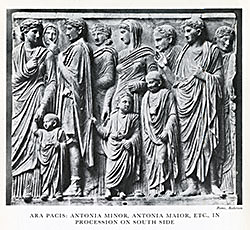
Entire slab at far right of frieze with children, one of the prime surviving original slabs of the Ara Pacis. Compare drawings at left.
"Plate XVIII Ara Pacis: Antonia Minor, Antonia Maior, etc., in Procession on South Side".
"Rome, Anderson"
Scanned from Toynbee, The Ara Pacis Reconsidered and Historical Art in Italy, London: British Academy, 1953, pl.18. © The British Academy 1953. Reproduced by permission from Proceedings of the British Academy, vol. 39; with appreciation. |














